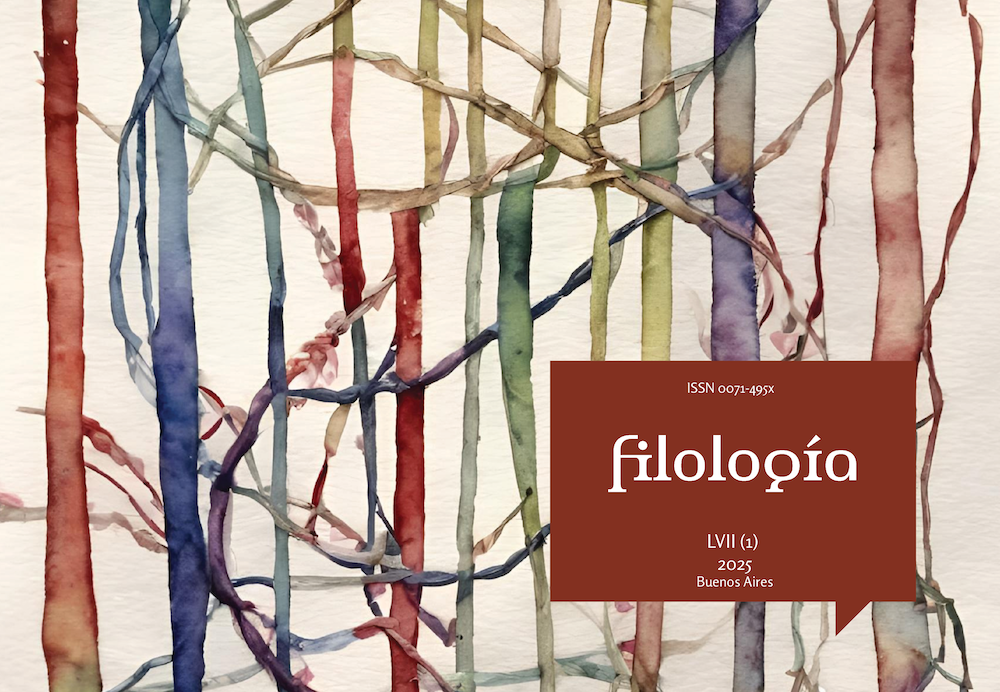Facets of Indescribability: The Case of COVID 19 Narratives
Abstract
The difficulty of expressing or describing through language (the unsayable or the indescribable) has been a relatively overlooked topic in the field of linguistics until quite recently, despite being a frequent and relevant experience in various communicative situations. In this paper, I first aim to present some contributions and discussions that have taken place within the framework of conversational analysis in the German language (Gülich, 2020), specifically focused on the study of conversations between doctors and patients suffering from epilepsy. Secondly, building on this foundation, I seek to delve into and shed light on some of the different facets of indescribability, drawing on reflections based on lexicographic resources and, fundamentally, on the analysis of various illness narratives produced by Rioplatense Spanish speakers suffering from COVID 19. The qualitative and exemplary analysis, guided by the theoretical-methodological developments of a particular approach to discourse analysis with a linguistic imprint (Gülich and Kotschi, 1995; Gülich, 2007), allows for the proposition that indescribability, understood both as a formulation resource and as a generic characteristic, could be considered a predominant attribute of these narratives about the experience of suffering from COVID 19, a thesis that should be tested on a larger corpus.Downloads
References
Antos, G. (1982). Grundlagen einer Theorie des Formulierens: Textherstellung in geschriebener und gesprochener Sprache. Niemeyer.
Aura (síntoma). (31 de agosto de 2024). En Wikipedia. https://es.wikipedia.org/w/index.php?title=Aura_(s%C3%ADntoma)&oldid=162190558
Bergmann, J. y Luckmann, T. (1995). Reconstructive genres of everyday communication. En U. Quasthoff (Ed.), Aspects of oral communication (pp. 289-305). De Gruyter.
Brünner, G. y Gülich, E. (2002). Verfahren der Veranschaulichung in der Experten-Laien-Kommunikation. En G. Brünner y E. Gülich (Eds.), Krankheit verstehen. Interdisziplinäre Beiträge zur Sprache in Krankheitsdarstellungen (pp. 17-93). Aisthesis Verlag.
Ciapuscio, G. (2016). Conceptualizaciones metafóricas y recursos de formulación en narraciones de pacientes con migraña. Oralia, 19, 39-60.
Ciapuscio, G. (2017). “Es como que se me forma una burbuja acá”: Procedimientos metafóricos en la interacción cardiólogo-paciente. Oralia, 20, 69-92.
Ciapuscio, G. (2022). Narrativas del dolor: técnicas conversacionales y recursos de mitigación e intensificación. Rilce. Revista de Filología Hispánica, 38, 967-994.
Ciapuscio, G. (2024). El glosario de voces quichuas en la edición de Ángel Rosenblat de los Comentarios reales de los incas. Crónica de la lengua española 2023-2024. Real Academia Española. https://www.rae.es/sites/default/files/2024-09/T_10341352_CiapuscioGuiomar.pdf.
Ciapuscio, G. y Bregant, L. (en prensa). El papel del marcador como en la contextualización de metáforas y escenarios en la producción discursiva. Lengua y Sociedad. Revista de Lingüística Teórica y Aplicada, 4(1).
Chauviré, C. (2010). L’art et le mythe de l’indescriptible. Philosophie en cours, 1, 15-26.
Curtius, E. R. (1995). Literatura europea y Edad Media latina (Vol. 1). Fondo de Cultura Económica.
Frenkel, J.-J. y Normand, C. (1998). Introduction. On ne peut pas me dire: “il faut le taire”. Linx, Revue des linguistes de l’université Paris X Nanterre, 10, 7-12.
Garcilaso Inca. (1943-1944). Comentarios reales (ed. de Á. Rosenblat). Emecé.
Gülich, E. (2007). “Volle Palette in Flammen.” Zur Orientierung an vorgeformten Strukturen beim Reden über Angst. Psychotherapie & Sozialwissenschaft: Zeitschrift für qualitative Forschung und klinische Praxis, 9(1), 59-87.
Gülich, E. (2020). Mündliches Erzählen (S. Pfänder, C. E. Scheidt y E. Schumann, Eds.). De Gruyter.
Gülich, E. y Furchner, I. (2002). Die Beschreibung von Unbeschreibbarem: Eine konversationsanalytische Annährung an Gespräche mit Anfallskranken. En I. Keim y W. Schütte (Eds.), Soziale Welten und kommunikative Stile. Festschrift für Werner Kallmeyer zum 60. Geburtstag (pp. 161-186). Narr.
Gülich, E. y Kotschi, T. (1995). Discourse production in oral communication. En U. Quasthoff (Ed.), Aspects of oral communication (pp. 30-66). De Gruyter.
Gülich, E. y Schöndienst, M. (1999). “Das ist unheimlich schwer zu beschreiben.” Formulierungsmuster in Krankheitsbeschreibungen anfallskranker Patienten: differentialdiagnostische und therapeutische Aspekte. Psychotherapie und Sozialwissenschaft. Zeitschrift für Qualitative Forschung, 1(3), 199-227.
Kiviniemi, A. L. (2015). Dire l’indicible et décrire l’indescriptible: Ressources imagières et linguistiques des poilus. Semiotica, 207, 139-174.
Olza, I.; Koller, V.; Ibarretxe-Antuñano, I.; Pérez-Sobrino, P. y Semino, E. (2021). The #ReframeCovid initiative: From Twitter to society via metaphor. Metaphor and the Social World, 11(1), 98-120. https://doi.org/10.1075/msw.00013.olz
Surmann, V. (2005). Anfallsbilder. Metaphorische Konzepte im Sprechen anfallskranker Menschen. Königshausen & Neumann.
Wittgenstein, L. (1966 [1921]). Tractatus logico-philosophicus. Suhrkamp.
Zimmermann, A. (1994). Laudationes auf Wissenschaftler. En Linguistik der Wissenschaftssprache (pp. 217-245). De Gruyter.
Diccionarios
Larousse Editorial. (2016). Disponible en línea https://www.diccionarios.com/diccionario/espanol/ [29/12/24]
Plager, F. (Coord.) (2008). Diccionario integral del español de la Argentina. Tinta Fresca-Voz Activa.
Real Academia Española. Diccionario de la lengua española, 23.ª ed., [versión 23.8 en línea]. https://dle.rae.es [29/12/24].
Copyright (c) 2025 Guiomar Elena Ciapuscio

This work is licensed under a Creative Commons Attribution-ShareAlike 4.0 International License.













